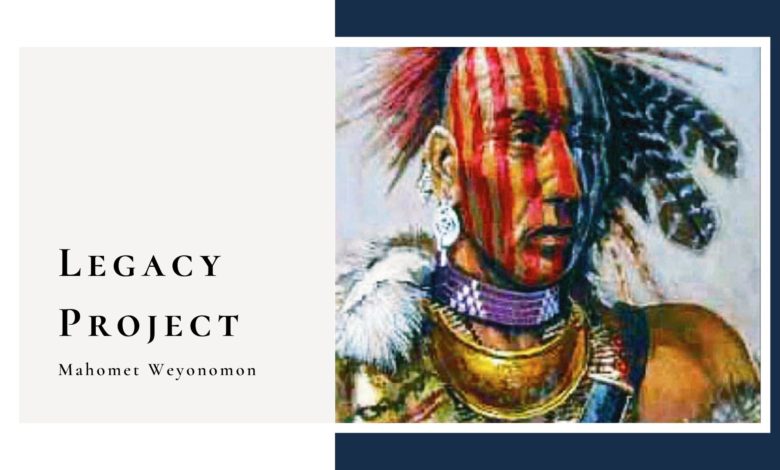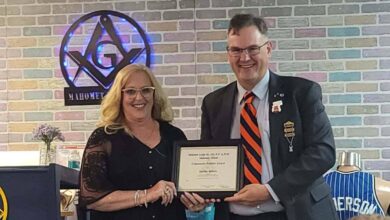East Central Illinois Legacy Project: Mohegan Sachem Mahomet Weyonomon

In East Central Illinois, we are on the lands of the Peoria, Kaskaskia, Piankashaw, Wea, Miami, Mascoutin, Odawa, Sauk, Mesquaki, Kickapoo, Potawatomi, Ojibwe, and Chickasaw Nations. Although it has not been recorded that Natives lived on land in Champaign County because of its marshy qualities, the tribes nearby surely hunted on the land before it was cultivated to become some of the best farmland in the United States.
With a railroad on the horizon, white settlers moved westward finding home in the area to become Champaign County. Daniel T. Porter from Middletown, Connecticut came to settle in the place now known as Mahomet, carrying his former town’s name with him.
There was another town in Illinois named Middletown, though. As the railroad expanded, Porter had to find a new name for his new settlement. He chose Mahomet as a way to remember Mohegan Sachem (chief) Mahomet Weyonomon (muh-HOMM-it), who Americans refer to as an ally.
According to Mohegan Tribe history, Natives were being decimated by diseases brought by the English settlers while they also had to find ways to preserve their culture, beliefs, and language (Algonquian) as English settlements took shape on the land they held sacred.
The Mohegan Tribe was part of the Pequot Tribe under the leadership of Sanchem Sassacus in the early 1600s. When a disagreement came forth in the tribe, the Mohegan, the “Wolf People”, were formed with Uncas, Mahomet’s great-grandfather, as their leader.
According to mohegan.nsn.us, “The Pequots under Sassacus chose to fight them (the English), with other local tribes taking sides. Seeing the loss brought on by continued fighting, Uncas befriended the European invaders. This controversial decision left Uncas and the Mohegans in an uneasy alliance with the English in an ensuing war with the Pequots. But staying true to their word, the Mohegans helped the English defeat the Pequots.
“Uncas settled his people in a village at Shantok, which the Tribe defended from a Narragansett invasion sparked by European as well as Indian conflicts. Finally, the Mohegan Tribe’s affiliation with the English kept its people relatively safe during King Philip’s war and beyond.”
Like so much of Native history, which relied on its oral tradition, recorded accounts of events are often relayed through a Colonial, Christian lens. Unlike some tribes, the Mohegan tribe did live to see centuries pass on a reservation in the eastern upper Thames River valley of south-central Connecticut.
Today, the Mohegan are working to honor their ancestors, revive their language, and to preserve important cultural artifacts and traditions for generations to come.
As Americans work towards recognizing the innate goodness of all cultures and healing generational wounds, it is important to not just tell a bit of the story. To solely account Mahomet and his ancestors as great English allies is to forget about the harsh realities that Natives faced and continue to face.
As the Mohegan helped the first settlers in New England survive the bitter cold and repel Indian attacks, the settlers also stole their land.
Queen Anne’s Commissioners granted the return of Mohegan lands by an order of 1705 but this was ignored by the Connecticut government. Mohomet sailed to London in 1735 with three supporters to petition King George II for the return of the stolen lands.
While awaiting an audience, Mohomet, at the age of 36, died in Aldermanbury in the City of London after contracting smallpox. Because he was a foreigner, he could not be buried inside the city while his traveling companions were.
Mohomet was carried across the river and buried near St Saviour’s Church, now Southwark Cathedral, although the exact location is unknown.
It wasn’t until 270 years later that Mohomet received the burial he deserved. Joined by Bruce “Two Dogs” Bozsum of Uncasville, Connecticut, Queen Elizabeth II remembered the man who crossed the Atlantic in 1735 with a letter that painted a stark picture of life for a tribe whose land was “reduced to less than 2 miles square out of the large territories for their hunting and planting.”
Weyonomon wrote that, without the king’s help, his tribe would be “reduced to the miserable necessity of leaving their native lands.”
Bozsum carried that letter with him to Queen Elizabeth on November 2, 2006, during Mahomet’s memorial ceremony.
A granite sculpture, carved with grooves meant to echo mountain trails, can be found in memoriam to Mahomet outside Southwark Cathedral.
The Mohegan tribe includes about 2,000 members.
In 1997 the Mohegan Tribe’s Council of Elders adopted the following Vision Statement:
We are the Wolf People, children of Mundo, a part of the Tree of Life. Our ancestors form our roots, our living Tribe is the trunk, our grandchildren are the buds of our future.
We remember and teach the stories of our ancestors. We watch. We listen. We learn.
We respect Mother Earth, our Elders, and all that comes from Mundo.
We are willing to break arrows of peace to heal old and new wounds. We acknowledge and learn from our mistakes.
We walk as a single spirit on the Trail of Life. We are guided by thirteen generations past and responsible to thirteen generations to come.
We survive as a nation guided by the wisdom of our past. Our circular trail returns us to wholeness as a people.
Mahomet is also found spelled as Mamomet and Mohomet.



